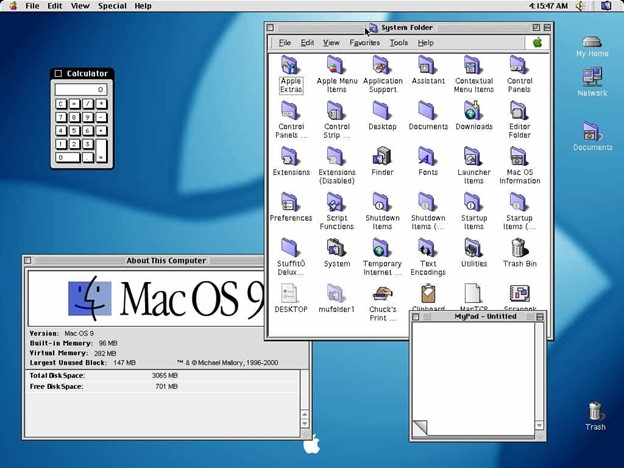Consider that Apple’s biggest digital transformations came about “before.” Before the financial crisis, before COVID, before our expectations changed. Apple’s innovations made way for the transformation of our world. Let’s break down a few of Apple’s practices and see if they apply to your business:

OS 9, circa 1999. Gonna be honest, it worked really well.

This means that they wait until a product is perfect before releasing it. When you’re a corporation, wary of espionage, this makes a lot of sense. However… that’s not to say that Apple, or any company, should be releasing products without proving there’s a market for them. How they do that, is their MVP.
“Minimal Viable Product” (MVP) does not mean “releasable product.” An MVP can be a market test or a prototype. It can even be a completely offline service improvement. You don’t have to release an MVP to the public. It’s a means of learning before you go “All in.”
What Apple tends to release is Minimum Marketable Products. What’s the least we can do to create a splash in the market? For example, OS 10 was an MMP; the iPod was an MMP. The iTunes Store was an MMP that grew into the App Store. The first release of the Vision Pro could be considered an MMP as well.
The reality is that an MVP should not always be put to market. And there’s no right way to create one. It’s a means of finding out if your idea has legs before investing a lot of money in it, like the Vision Pro announcement and marketing video.
Do you have an idea? How might you test your idea?
Apple doesn’t ask their customers what they like. But that doesn’t mean they don’t learn from their customers. What do you think Apple could learn from the Apple Vision Pro PR campaign?
There’s a misattributed quote: “If I had asked people what they wanted, they would have said faster horses.” It may never have been said, but it’s true nonetheless. Don’t ask.
Observe what they’re doing
Discover why they’re doing it
Uncover their challenges
This is the heart of the Jobs-to-be-Done approach to product innovation, and it’s a really powerful way to approach product-solution fit. It forms the foundation for your Product Vision, which is the most powerful tool in your arsenal when you’re trying to change your company and bring your team along with you.
What is a Vision Statement?A Vision statement is more than an idea. It’s an aspirational, but attainable, goal for your digital product that is backed by research. It’s the destination for your roadmap, and it will keep your team aligned during chaotic times. |

Times have changed since Steve Jobs took Silicon Valley by storm. Steve was a visionary, and he found a top-down approach really worked for him. He had a strong vision and held a strict eye over everyone to make sure every detail was just right. However, that ethos contributed to a culture many people found off-putting and may not be right for your business. It may not even be implementable.
The reality is that your customers and your employees have more choices than ever. They can refuse to buy. They can refuse to adopt change. They can leave your company.
You can still be a visionary and ensure digital product success. It relies on you to get really good at articulating your vision. A strong digital product vision backed by cross-functional Agile approaches can give you the oversight and direction you need and empower your team to solve problems in creative ways.
In my humble opinion, I wouldn’t look to Apple as a model for a new product. The political, social, and world economic situation has changed so much since the iPhone (thanks to the innovations they brought about). Apple’s own market position is also incredibly unique and hard to replicate. Instead, let’s take the lessons we learned from successful businesses like Apple, and Amazon and use that to imagine a new future. One that works in the modern era, tailored for your company, with your people. It’s not rocket science unless you are, of course, innovating rockets.
If you’d like to know more about how to turn your Vision for your organization into a digital product while also amplifying your culture, be sure to contact our Digital Studio here.
About The Author
Adelle Rewerts, Principal Consultant & Senior UX Architect

Adelle Rewerts is a Principal Consultant and User Experience Architect in Online’s Digital Studio. She’s been at the forefront of digital product strategy for over 20 years. Her background in innovation, product, data, and user experience aligns business visions, technical realities, and user context to create effective products. But the best part is the way she empowers and engages teams to do great work.





Submit a Comment